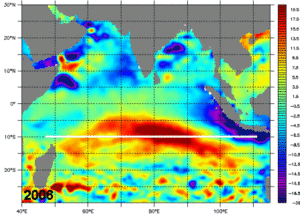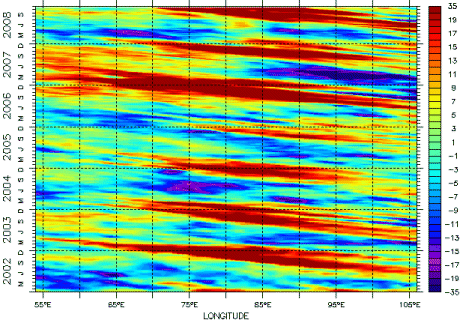Indian Ocean Dipole (IOD) by the LAS
Lively Data: December 22, 2008

The Indian Ocean Dipole (IOD) is an air-sea coupled climate mode in the Indian Ocean with some positive and negative events. It has large climate impacts: floods in East Africa and droughts in Indonesia and parts of Australia and Indian summer monsoon rainfall remains above normal during a positive IOD. IOD generally starts to develop in boreal summer, peaks in fall and terminates in winter, subject to the strong seasonal surface winds.
Three consecutive positive IOD events have occurred in 2006, 2007 and 2008. No such previous occurrences had already been recorded.
Maps made with the LAS can easily draw the spatio-temporal evolution of this phenomena. with the longitude-time hofmoeller diagram (xt). A first map on averaged Sea Level Anomalies during the strong positive IOD in 2006 boreal fall (Sept. Oct. Nov.), clearly show the signature of this event : a negative SLA along the west coasts of Sumatra and positive SLA in the western Indian Ocean.
A longitude-time diagram (also called Hovmoeller, xt) also show these positive anomalies that move towards west, the strong event in 2006 and the three consecutive events since this date.

Further information:
- Lively Data:
- October 21, 2008: An unusually strong Indian monsoon
- JAMSTEC, Observations, Seasonal forecasts of the Indian Ocean Dipole
![]() Use the Live Access Server
Use the Live Access Server




